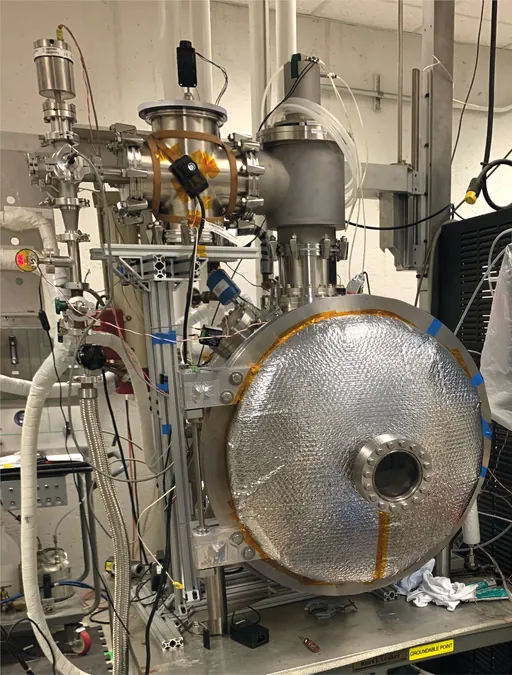
NASA’s SCALPSS 1.1 to Reveal Moon’s Surface Secrets During Blue Ghost Landing!
2024-12-22
Author: Emma
NASA’s Next Lunar Mission
NASA is gearing up for another monumental lunar mission, this time focusing on how rocket plumes interact with the Moon's surface. As part of an innovative endeavor, the agency is sending the Stereo Cameras for Lunar Plume-Surface Studies (SCALPSS) 1.1 aboard Firefly's Blue Ghost lander. Prepare for a celestial spectacle that promises to unveil the Moon's surface dynamics like never before!
Technology Behind SCALPSS
The SCALPSS technology, developed at NASA's Langley Research Center in Virginia, consists of a sophisticated array of six cameras strategically positioned around the lunar lander's base. This advanced setup enables researchers to capture high-definition imagery before, during, and after the lander's descent—paving the way for groundbreaking insights into the effects of rocket plume interactions with the lunar regolith.
Lessons from SCALPSS 1.0
This upcoming mission marks a significant evolution from its predecessor, SCALPSS 1.0, which was aboard the Intuitive Machines' Odysseus spacecraft. Unfortunately, that mission faced landing complications that prevented successful imagery acquisition. However, the lessons learned have infused the SCALPSS 1.1 system with greater capabilities, featuring additional cameras to enhance data collection accuracy. This is monumental, as the high-altitude imaging will present vital pre- and post-landing analysis.
Understanding Lunar Surface Changes
The critical question at hand: How much will the Moon's surface change during landings, especially as more missions are planned in close proximity to one another? Scientists are eager to learn how rocket plumes alter the lunar soil—insight that is increasingly relevant as lunar exploration accelerates, particularly under NASA's Artemis campaign aimed at establishing a sustained human presence on the Moon.
Expert Insights on Lunar Landings
Michelle Munk, principal investigator for SCALPSS, emphasizes the importance of understanding these interactions: "When placing landers and habitats side by side, there's a real risk of one affecting the integrity of another with debris or soil displacement. Anticipating this will be key to designing future lunar missions."
Part of NASA’s CLPS Initiative
The SCALPSS 1.1 payload is part of NASA’s Commercial Lunar Payload Services (CLPS) initiative, which supports partnerships with commercial entities. This mission will not only feature over 200 pounds of scientific equipment but also mark a crucial step towards understanding how to mitigate potential impacts on lunar assets.
Data Collection and Future Implications
Upon completion of the landing, the images collected will be stored onboard before being transmitted back to Earth. The processing and validation of this data could take several months, yet the potential findings are already creating a buzz within the scientific community. Researchers anticipate observing erosion that, while not extensive, will greatly enhance our understanding of the lunar surface.
Critical Data for Future Missions
Rob Maddock, project manager for SCALPSS, highlights the importance of this mission for future exploration. Upcoming human landing systems, featuring even larger engines than those used in the Apollo missions, will likely create significant disturbances on the lunar surface, making this data critical for planning and executing safe lunar operations.
Conclusion
In the rapidly evolving landscape of space exploration, the SCALPSS 1.1 mission stands as a testament to NASA’s commitment to collaboration, innovation, and groundbreaking discoveries on the Moon. Buckle up for what promises to be an unforgettable journey to our closest celestial neighbor!









 Brasil (PT)
Brasil (PT)
 Canada (EN)
Canada (EN)
 Chile (ES)
Chile (ES)
 España (ES)
España (ES)
 France (FR)
France (FR)
 Hong Kong (EN)
Hong Kong (EN)
 Italia (IT)
Italia (IT)
 日本 (JA)
日本 (JA)
 Magyarország (HU)
Magyarország (HU)
 Norge (NO)
Norge (NO)
 Polska (PL)
Polska (PL)
 Schweiz (DE)
Schweiz (DE)
 Singapore (EN)
Singapore (EN)
 Sverige (SV)
Sverige (SV)
 Suomi (FI)
Suomi (FI)
 Türkiye (TR)
Türkiye (TR)